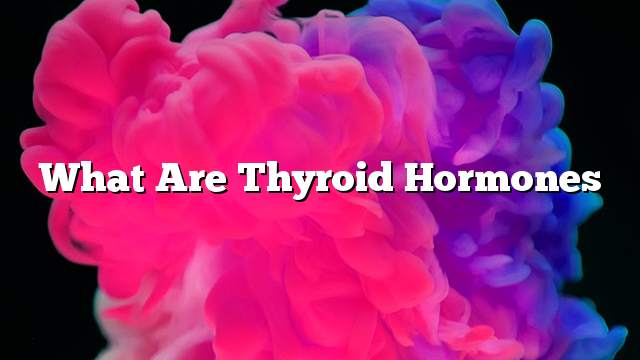Thyroid is one of the largest endocrine, shaped like a butterfly, located at the front of the neck and twist around the throat under the thyroid cartilage, which forms the emergence of the throat in the so-called Adam’s apple. Controls the speed of metabolism (ie burning energy sources in the body from proteins or fats or carbohydrates), making proteins, controlling the body’s sensitivity to other hormones, and has an important role in the development and differentiation of all cells of the body, and controls the way Is known for neural activity, which is important in the hibernation cycles of some types of mammalian animals, and this is the entire organization through the secretion of thyroid hormones; the hormone tetra iodo theronin (thyroxine (T4) and the hormone tri-iodo thionine (T3) (T3) and (T4) relative to the initial character of the gland name and E And the letter T in English, and the number symbolizes the number of iodine atoms in the hormone compound.
Thyroid hormones (T3) and T4 are originally organic compounds made up of proteins based on amino acid (tyrosine) and iodine atoms, which are the essential and important element in these compounds. Fat-loving hormones are considered fat soluble. The thyroid hormone is the thyroxine (T4). T-3 is 99.9% to 0.1%, and the half-life is half the age of the hormone T3. T3 is the active hormone that performs the desired function of the thyroid gland, and T4 is the vanguard of the T3 hormone. Thiroxine is transformed into its active form (T3) by the enzyme deiodine when it enters. Target cells, so some scientists use the term (thyroid hormone) and not (thyroid hormones).
The production of thyroid hormones is regulated and pumped into the blood via a hormonal mechanism that starts from the hypothalamus, which produces a hormone called the thyrotropin-trh hormone, which is sent to the pituitary gland to secrete the thyroid hormone (TSH) It is sent to the thyroid gland to release its hormonal storage in the blood (it is endocrine, ie, it does not have channels for the substances it produces to deliver it to the desired cells). The two hormones are transported in the blood in two ways: unconnected free hormones, and hormones linked to transporter proteins that are separated from them when they reach the target cells. Most of the amount of hormones is transferred in a linked form and only a very small amount of the unconnected form is carried out with the blood and is the active form of the hormone. The ratio of T-3 to T-4 is very important in the diagnosis. For example, if the free T-4 ratio is high compared to the free T3, this is evidence of hypothyroidism without the need for this activity. When the hormones reach the target cells, they cross the cell membrane through energy-efficient protein-producing channels to function (in order to control their entry into the cell as needed), and also because the size of the hormonal compounds exceeds the ability of the cell to transfer from the outside to the inside in the form of cytotoxic or diffuse ), And then reach the nuclear membrane to bind to their own receptors on this membrane, the response is desired by the nucleus of the cell.
The levels of these hormones are detected by a sample of blood and thus determine whether the person has hyperthyroidism or hypothyroidism. The free form of the hormone is measured in the blood and not associated with the transport proteins (which are important indicators of hormone activity in the body) or by measuring the total proportion of both hormones (the form associated with the free form), but this examination is not preferred because the proteins that are susceptible to physiological conditions Such as pregnancy or taking medications. The normal levels of the total T-4 hormone in the blood range between 4.5-12.5 μg / 100 ml (65-160 nmol / l), while the normal level of total T3 hormone in the blood ranges between 0.07-0.17 μg / 100 ml of blood (0.91 – 2.2 nmol / l). The normal level of free T-4 hormone is 0.8-2.4 ng / 100 ml (0.01-0.03 nmol / L).
